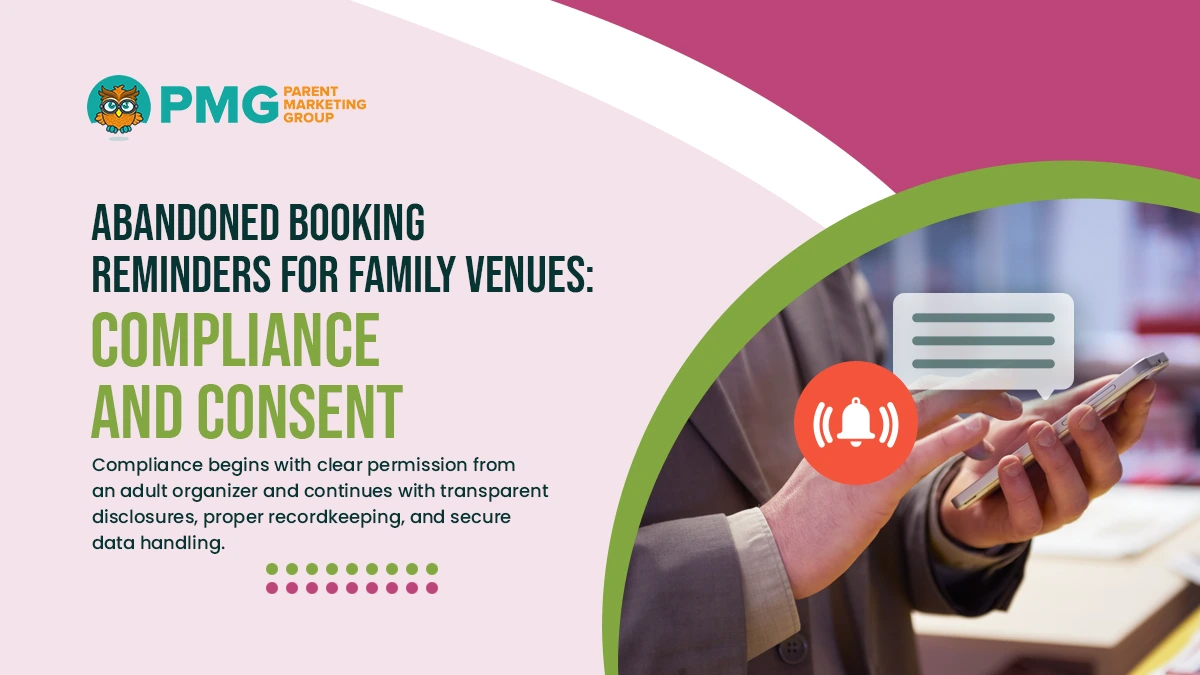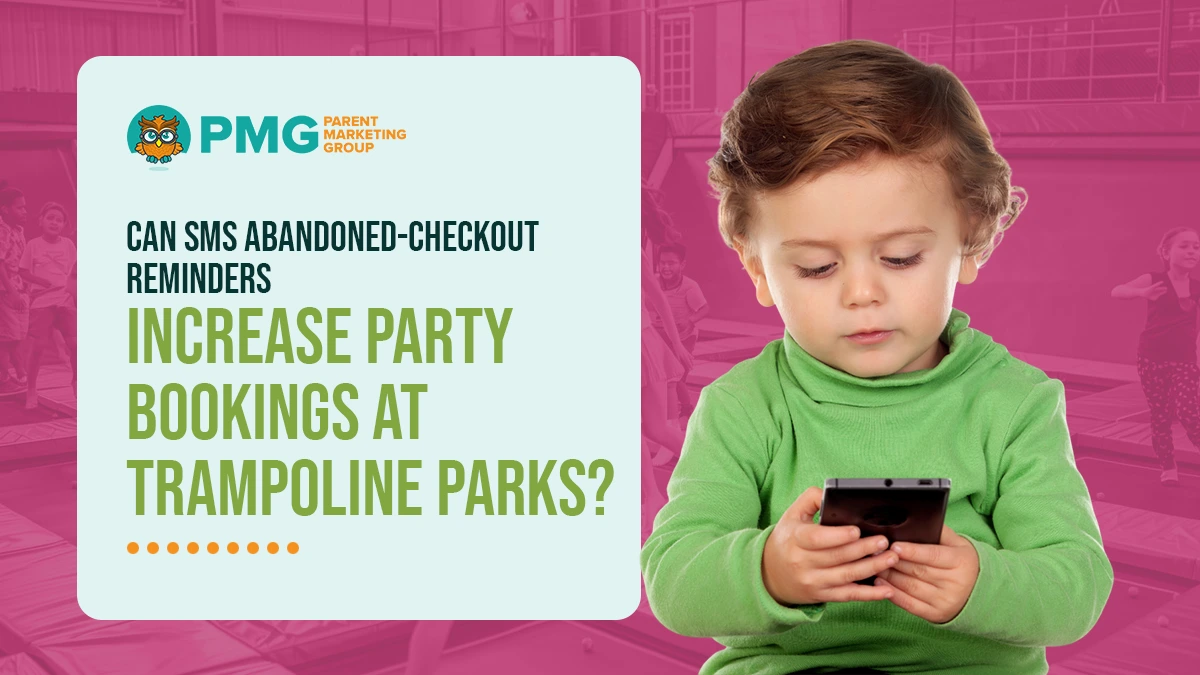SMS abandoned cart reminders for trampoline parks convert incomplete bookings into deposits by contacting parents promptly to finish checkout. When connected to your booking engine, these messages restore the exact cart, including date, headcount, and package, and provide a secure link to resume payment without re-entering details.
Effective programs use explicit opt-in, respectful timing (send 15–60 minutes after abandonment with one same-day follow-up), and concise copy that clarifies deposits, rescheduling, and waivers. Personalization with the organizer’s first name and selected package raises relevance. Track recovery rate, deposit conversion, and average order value to refine cadence, copy, and incentives.
Recovery Messages for Trampoline Party Bookings: Timing and Content

Recovery messages work when they arrive soon after a stalled checkout and make finishing the booking effortless. The goal is a brief reminder that restores the cart, clarifies policies, and gives a direct path back to payment.
Abandonment Windows and Cadence
Send reminders quickly enough to catch the planner while details are fresh, then taper to avoid fatigue.
- First reminder (15–30 minutes): A short prompt that restores the exact cart and date selection.
- Second reminder (2–4 hours): Address common blockers such as deposit rules or headcount changes.
- Final same-day check (within 24 hours): Note limited time-slot availability without adding pressure.
- Auto-suppress after conversion: Stop all reminders once a deposit is recorded.
This cadence balances recovery potential with respectful spacing and protects the list’s health.
Message Structure and Clarity
Keep copy concise and focused on finishing the task. Reference what was selected and remove uncertainty.
- Context line: State the chosen party package, date, and chosen headcount.
- Value cue: Remind families that the slot is held only after completing a deposit.
- Next step CTA: Provide a plain “Resume booking” link that returns to the review screen.
- Help path: Offer a host number or FAQ link for policy and waiver questions.
Two to three short sentences are sufficient when the link restores the cart and policies are visible.
Secure Return Links and Cart Restore
Deep links should reopen the exact itinerary and reflect live availability.
- One-tap secure link: Use tokenized URLs that expire after a reasonable window.
- Policy preview: Surface deposit, reschedule window, and waiver summary above the pay button.
- Inventory awareness: Hide sold-out times and offer nearby alternatives automatically.
- Tracking tags: Attribute recovered deposits back to the reminder for measurement.
Accurate restore behavior reduces re-entry friction and increases completion rates.
Quiet Hours and Local Timezone Handling
Respectful timing improves engagement and compliance. Align sends it at the organizer’s local time.
- Local timezone send: Convert triggers to the recipient’s timezone to avoid off-hour messages.
- Quiet hours: Limit sends during late evening and early morning unless explicit consent allows otherwise.
- Opt-out keywords: Honor STOP, HELP immediately, and log consent status.
- Pacing rules: Cap daily and weekly sends and coordinate with email to avoid overlap.
These controls keep reminders helpful, compliant, and welcome.
SMS Follow-Up for Trampoline Park Checkout: Cadence and Copy

SMS follow-ups should arrive while the intent is fresh and make completion effortless. Establish a simple cadence that respects guests’ time and maintains list health.
Cadence Framework and Send Windows
Start with a concise sequence aligning with typical planning behavior and staff capacity.
- First Reminder (15–30 Minutes): A brief prompt that restores the exact cart and selected time.
- Second Reminder (2–4 Hours): Addresses common blockers such as deposits, waivers, or headcount edits.
- Same-Day Check (Within 24 Hours): Notes limited availability and offers alternatives if the slot changes.
- Suppression After Deposit: Stops all messages once the payment posts and sends a confirmation.
Review performance weekly and adjust the gaps between reminders to protect engagement and reduce opt-outs.
Copy Principles and Personalization
Keep the copy short, specific, and action-oriented. Personalize with the organizer’s first name and the package to increase relevance.
- Context First: Reference package, date, and party size to confirm the correct cart.
- Plain CTA: Provide a single “Resume booking” link that returns to the review screen.
- Policy Clarity: State deposit amount and reschedule window in one short line.
- Help Option: Offer a click-to-call host number or a concise FAQ link.
Limit to two or three sentences. Place the link on its own line to improve tap-through and reduce confusion.
CTA Variations and Paths
Offer a small set of choices that match common scenarios without adding friction.
- Resume Booking: Returns to the saved itinerary with live availability checks.
- Pick a New Time: Opens the same day with nearby time slots pre-filtered.
- Talk to a Host: Connects to staff for policy questions or guest count.
- Save as Draft: Holds selections for a short window when decisions require confirmation.
Track which CTA paths convert best by daypart and party size, then prioritize placement accordingly.
Frequency Caps and Compliance
Respectful pacing and clear controls sustain deliverability and trust.
- Quiet Hours: Avoid late-night and early-morning sends unless explicit consent exists.
- Opt-Out Keywords: Honor STOP and HELP immediately and log status changes.
- Local Timezone: Convert triggers to the recipient’s timezone before sending.
- List Hygiene: Suppress after conversion, dedupe against email, and cap weekly touches.
These standards protect brand reputation, reduce complaints, and keep recovery performance consistent.
Abandoned Booking Reminders for Family Venues: Compliance and Consent

Compliance begins with clear permission from an adult organizer and continues with transparent disclosures, proper recordkeeping, and secure data handling. Treat SMS as a consented service with a defined purpose, frequency, and controls.
Opt-In Standards and Required Disclosures
Collect explicit permission before sending any reminder. Present concise language when capturing and confirming the scope of messages.
- Explicit Opt-In: Use a checked-by-guest box or a typed phone field with a clear consent line.
- Purpose and Frequency: State that messages relate to abandoned checkout and list expected send cadence.
- STOP/HELP and Rates: Include “Reply STOP to opt out, HELP for help. Msg/data rates may apply.”
- Adult Organizer: Capture consent from a parent or guardian; do not target child devices.
Consider a brief confirmation text to verify the number and restate controls.
Proof of Consent and Auditability
Maintain durable records that show who consented, when, and under which terms. Store evidence centrally and make it searchable.
- Timestamped Evidence: Save date, time, source page, and IP or device ID.
- Consent Text Snapshot: Archive the exact disclosure language shown at opt-in.
- Collection Source: Tag origin, such as checkout, waiver form, Wi-Fi portal, or kiosk.
- Suppression Logs: Record STOP, HELP, and resubscribe events with timestamps.
Retain records according to policy and local regulations so that proofs are available during reviews.
Sender Identity, Message Scope, and Delivery Rules
Use a registered messaging route and keep content within the consented purpose. Identify the venue at the start of each message.
- Registered Route: Send via approved A2P 10DLC or short code; keep brand and campaign details current.
- Clear Identification: Begin with the venue name so recipients recognize the sender.
- Scoped Content: Limit texts to checkout recovery unless the guest opts into broader marketing.
- Quiet Hours: Respect local time windows and avoid late-night or early-morning sends.
Process STOP and HELP immediately and synchronize status with CRM and booking systems.
Data Protection and Vendor Controls
Protect guest data throughout the workflow and restrict access to operational needs.
- Least-Privilege Access: Limit phone and booking details to roles that require them.
- Data Minimization: Store only the fields needed for recovery, not complete card data.
- Retention and Deletion: Apply defined lifecycles for consent records and phone numbers.
- Vendor Agreements: Use contracts with privacy terms, security standards, and breach notice timelines.
Train staff on these rules and run periodic audits to ensure practices match written policies.
Integration With Booking Engine, POS, and CRM
A connected stack turns stalled checkouts into confirmed deposits without manual work. Integrate the booking engine, POS, and CRM so reminders restore the exact cart, reflect live availability, and attribute every recovery to the correct guest profile.
Deep Links and Cart Restore
Reminders should bring organizers back to the precise review screen with policies in view. That requires deterministic links and guardrails that keep data accurate.
- Tokenized return link: Use a time-limited URL that restores package, date, and headcount.
- Live availability check: Verify the slot on load and surface nearest alternatives if they have changed.
- Policy preview: Display deposit, reschedule window, and waiver summary above the pay button.
- One-click payment path: Preserve guest details so only confirmation and payment remain.
Confirm link behavior in staging and monitor failures so engineering can adjust parameters quickly.
Status Sync: Deposits, Waivers, and Headcount
Accurate status fields keep operations and messaging aligned. Sync key attributes to prevent double outreach and to prepare staff.
- Deposit status: Write payment outcome to the booking engine and CRM immediately.
- Waiver linkage: Attach signed waivers to the reservation and mark outstanding items.
- Headcount updates: Reflect changes from the checkout page in POS prep lists.
- Suppression flags: Stop reminders once payment or a manual booking is recorded.
Nightly audits should reconcile counts across systems and alert teams to mismatches.
Closed-Loop Reporting and Audience Updates
Marketing needs clear attribution and current segments for future outreach. Connect results to the guest profile and campaign.
- Profile writeback: Record recovered deposit, package, and date to the CRM timeline.
- Campaign attribution: Tag the booking with source, medium, and message variant.
- Segment rules: Automatically move guests from “abandoned” to “booked” audiences.
- Post-visit triggers: Start thank-you and review requests after the event date.
Consistent IDs across systems allow cohort analysis by daypart, package, and reminder step.
Webhooks and Offline Conversion Uploads
Real-time events and scheduled uploads keep platforms optimizing for revenue rather than clicks.
- Webhook events: Fire deposit and refund webhooks to update POS and CRM instantly.
- ETL schedules: Batch-send conversions with values to ad platforms for modeling.
- Error handling: Log retries and surface failures to a shared dashboard.
- Security controls: Sign payloads and restrict endpoints to required IP ranges.
These integrations ensure every recovered booking is measured, operationally visible, and used to improve future performance.
Conclusion
Effective SMS recovery is not a louder reminder; it is a helpful handoff back to a nearly finished plan. When the message restores the cart, clarifies policies, and arrives at the right moment, parents confidently complete the booking. The result is fewer abandoned checkouts and a steadier pipeline of party deposits. Sustainable performance comes from disciplined execution. Capture explicit consent, send on a measured cadence, and keep messages brief and specific. Connect booking, POS, and CRM so every reminder reflects live availability and every recovery is attributed to the correct profile.
Ready to turn stalled checkouts into confirmed celebrations? Call (716) 303-4133 or visit https://parentmarketing.com/contact-us.






